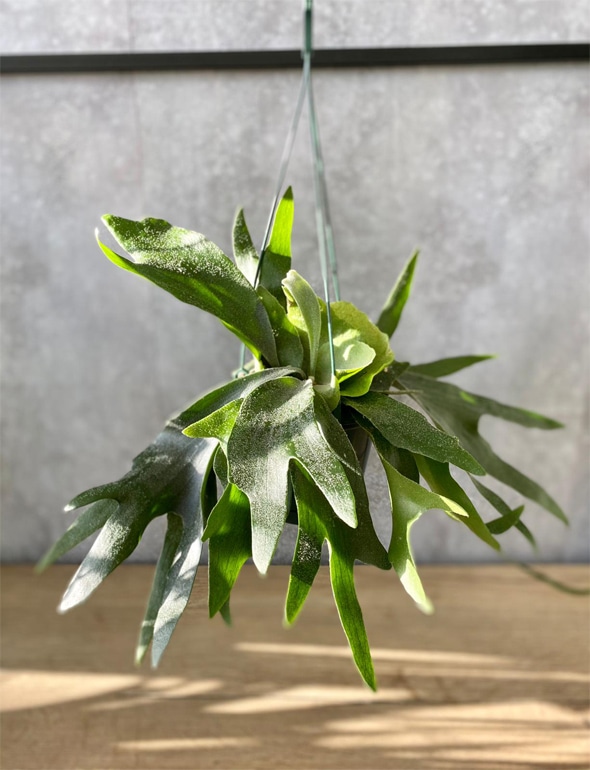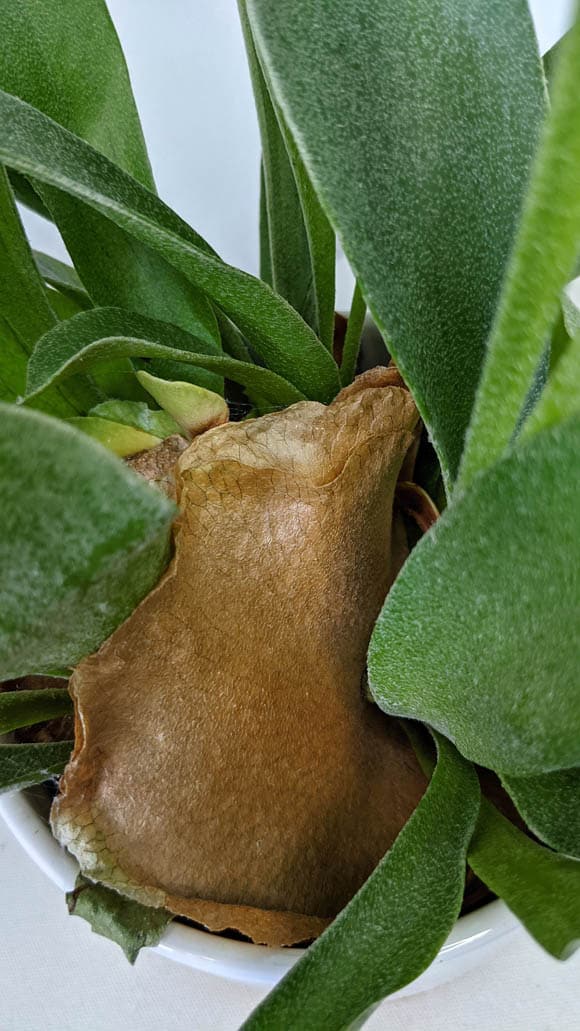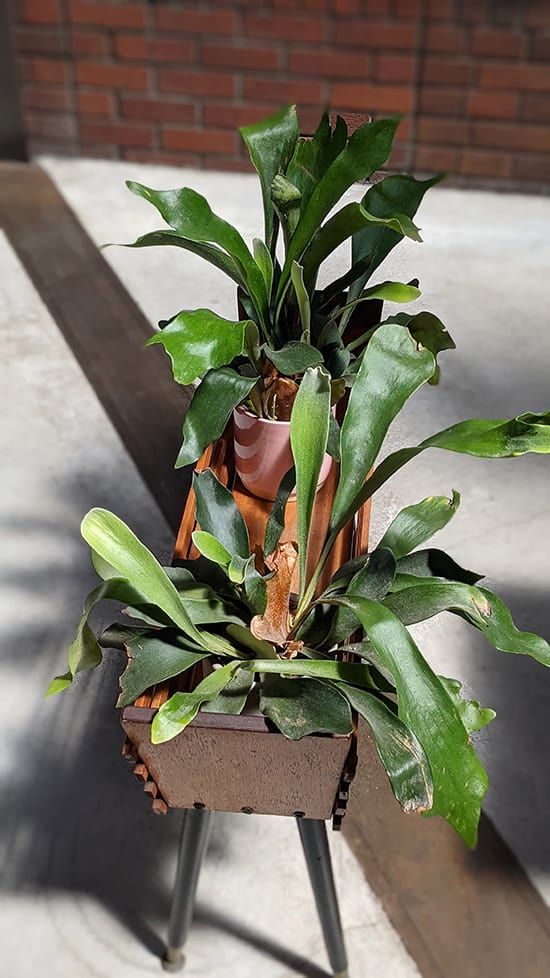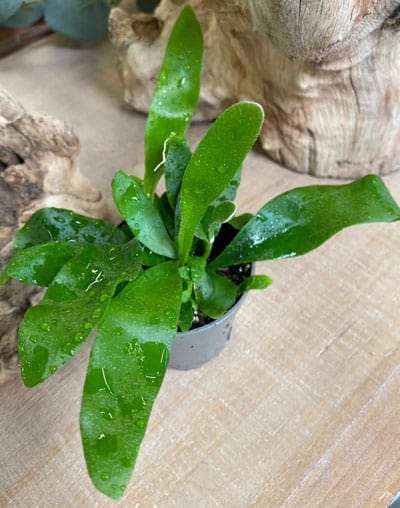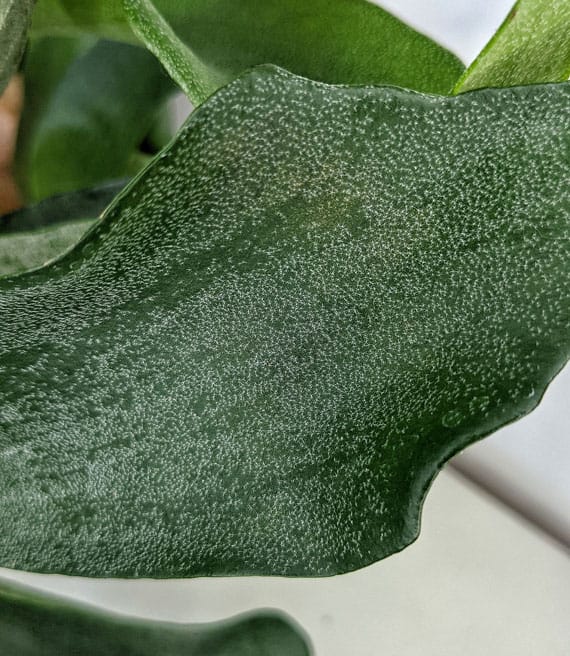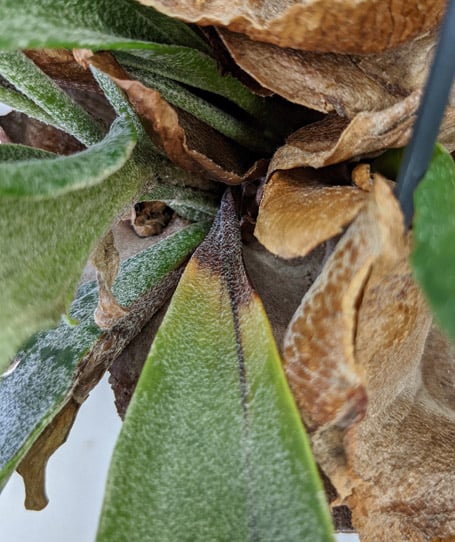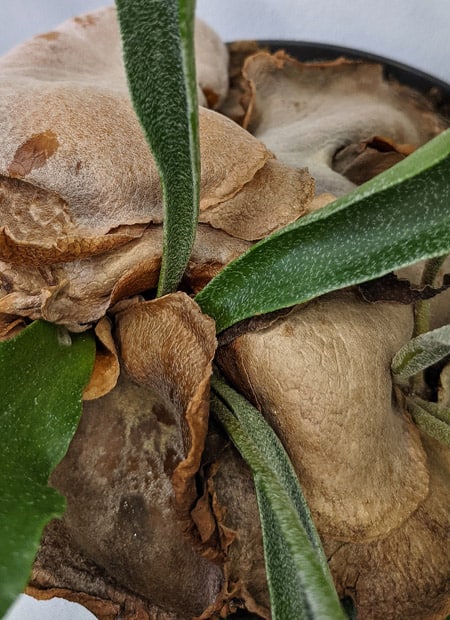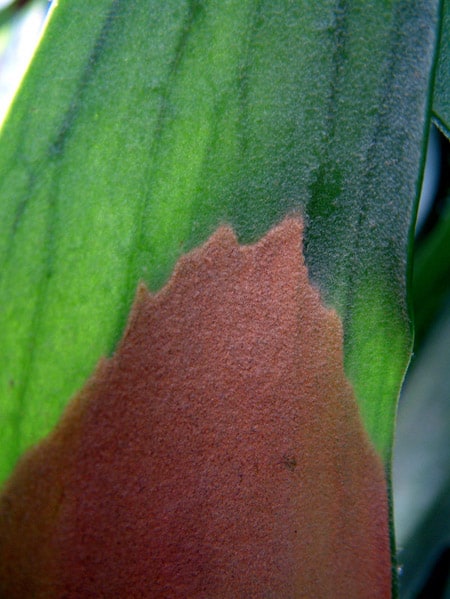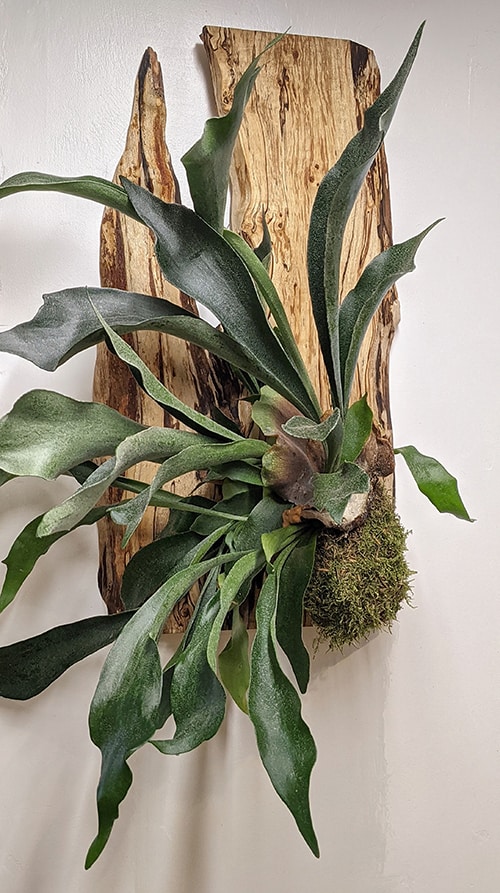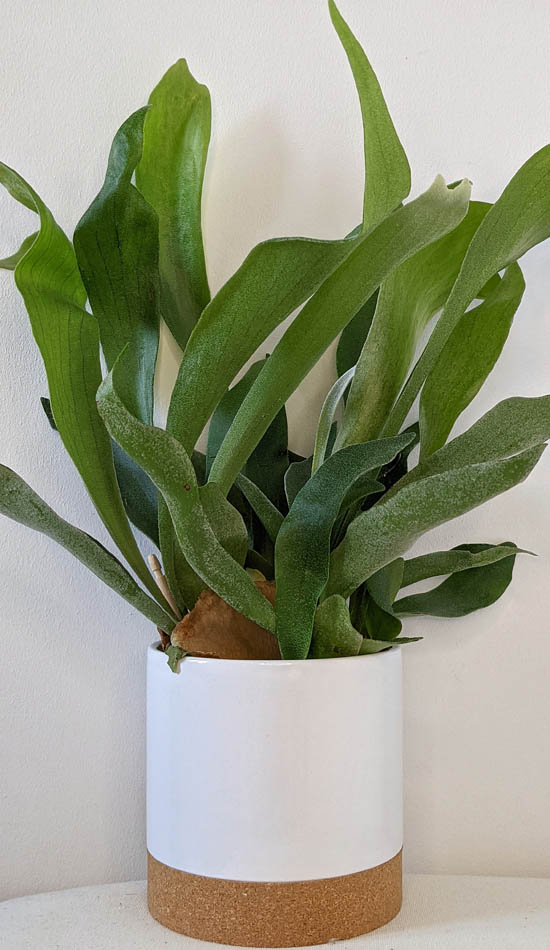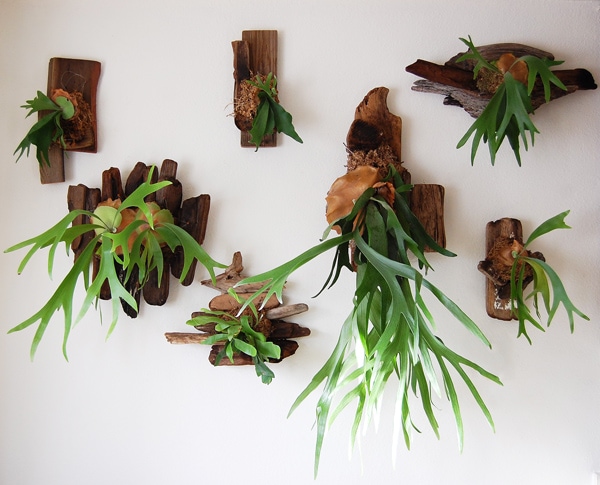The Staghorn Fern (sometimes known as the "Elkhorn Fern" or Platycerium bifurcatum) is a houseplant that will draw attention in almost all settings with its majestic shaped leaves that mimic the antlers of a stag.
You can grow these plants in pots or show them off by mounting them to a board and then hanging them from a wall.
Their grand appearance and relative rarity might give the impression Staghorn Ferns are fussy indoor plants, but this isn't true at all. While not truly easy-care plants, they're still pretty resilient and make excellent plants for anyone who has had a little houseplants experience.
Staghorn Fern (P. bifurcatum) for sale, being grown in a hanging basket showing off it's distinctive antler fronds.
Although widely available, they're not sold everywhere and prices can vary. They're fairly slow-growing plants so bigger specimens are going to cost more, as are those sold on striking or attractive mounts.
Small young plants growing in a pot of soil or bark should be reasonably priced and there is nothing stopping you from growing it on a little and then doing some DIY and mounting it yourself (I'll explain how later).
How do you pronounce Platycerium bifurcatum correctly? Say:
Plat-ih-SEER-ee-um
By-fur-KAY-tum
Platycerium are epiphytes which means out in their natural habitats, they cling to tree trunks or branches. Surviving off the occasional rainfall and catching falling leaves and debris, which rot down to provide nutrients.
It's a tough life compared to most houseplants! Fortunately, they've developed specialist adaptations to deal with these problematic growing environments and, as such, thrive in these places.
Did you know?
Bifurcate means to divide or fork, which describes the shape of the Staghorn's fronds. This is also how it got the common name of "Staghorn".
Their epiphtic nature is the reason Staghorns are commonly grown on mounts attached to walls. They're literally designed to grow in places like this. That said, they will still adapt to life in a pot for many years if that's how you prefer to grow them. In terms of how to care for a potted Staghorn Fern, you just have to treat them a little differently and I'll cover that later.
The leaves, commonly known as fronds, come in two types. The first are long-reaching with the stag antler-shaped ends and are called Fertile fronds or Foliar fronds. Young plants tend not to produce very pronounced shapes, but in maturity, they can be very rippled and divided. They will last for 2 or 3 years before being replaced with longer and bigger fronds.
The second type of growth happens towards the plant base and are called Basal, Sterile or Shield fronds. There is a picture of one in the photo below. You can see it's brown, but initially and for up to a year after, it will be green.
The brown leaf is a Basal Frond more commonly known as a Shield Frond. It helps protect the plant roots as well as take up water and nutrients.
Some of the adaptations of these plants can confuse new growers and can also cause the plant to be inadvertently mistreated. It's crucial that you don't remove the shield / basal fronds once they've gone brown. These parts might look like they've gone over, but they're still working hard and benefiting your plant. The shield frond helps anchor the plant in place and will also help protect the delicate root ball, and trap moisture in.
Secondly, the white, dust-like material on the fronds is not actually dust and should not be wiped off. It helps the plant to conserve moisture as well as provide protection from strong sunlight.

Hi, I'm Tom!
If you're like me and enjoy the challenge of growing houseplants and getting them to thrive, then Ourhouseplants can help. This website shares my knowledge and years of growing plants and provides (hopefully) helpful advice on properly caring for your indoor plant friends.
Epiphytic plants usually have it tough. Having to deal with unusual growing conditions and fairly extreme environmental variables. In their natural habitat, holding on to trees, Staghorns can be found growing in some semi-shady spots but also under some intense sunlight.
I've had my Stags growing in low light conditions and also receiving some mid-day sun! Both had slight drawbacks. The low light plant hardly grew and was too easy to overwater causing some rotten / dead leaves. The one in the harsh sun ended up with a few ugly scorch marks.
Can I grow this plant outside?
Yes you can. Many seasoned Staghorn Fern owners will move their plants outside from late Spring until the end of Summer. Bringing them inside before temperatures start dropping below 7°C (45°F).
Another interesting difference was the colour of the fronds. Darker leaves in the Stag grown in lower light and a much lighter green for the plant grown in strong bright light. Here's a photo showing two fronds from two different plants. The frond on the left is from the plant grown in lower light and the frond on the right is one growing in direct sunshine.
The perfect balance is a spot that does get a good deal of light but avoiding the intense sun. They'll grow in any aspect (North, East, South or West) providing the plant is not set back too far from a window. If positioned in a South facing window some shielding should be provided.
Fortunately, this is a reasonably forgiving houseplant with underwatering. It can definitely cope with drought and sporadic watering. It suffers significantly with overwatering however, especially those being grown in pots. Take care not to go overboard.
Expected Water Frequency?
On average, once a week or maybe every two during the warmer growing seasons and perhaps every two or three weeks in Winter. Individual plants will have unique needs depending on light, temperature and growing style, pot vs. mounted etc.
Water is absorbed directly through the roots but also through the fronds. This means you can "wet" the entire plant.
My plants love being taken into the shower once a month or so during the warmer and lighter months of the year. This thoroughly wets the fronds as well as the root ball.
The potting medium must be free draining. The roots don't want to be sitting around too much water for prolonged periods. If there is any kind of drip tray or container, be sure to pour any excess water away.
You can see me over on YouTube talk about my Staghorn plants too.
Coming from a tropical country, this plant is going to prefer higher humidity levels, but it's not a deal-breaker if your home can't provide this. The average home humidity is normally around 40% to 60% and this will be accepted by your plant.
Watch out for abnormal dry air spots in your home. Switched on radiators and air conditioning vents can both drastically lower humidity and cause problems.
Misting is an excellent idea as the fronds will absorb the water. This cuts back on the need to water your plant, but it has limited use for a pot-grown plant because all the water it needs is easily delivered to the root area anyway.
A Staghorn that's been mounted with sphagnum moss surrounding the root ball would really benefit as it will help keep the roots moist and reduce the need to constantly remove everything from the wall to water your plant.
Are banana peels good for staghorn ferns?
This might be an odd question to newbies, but it's well known that some Staghorn Fern owners will occasionally slip a banana peel under the shield frond. It eventually breaks down and provides nutrients.
A peel will provide potassium and phosphorus but very little nitrogen, needed for frond growth. So yes, you can definitely feed your fern this way if you like, but there are less messy and more efficient ways of doing it.
This fern is very capable of only having occasional feeding. It can still do well with very little feed, but this then becomes a surviving rather than thriving plant. I wrote an article about this concept if you want more insight into what this means.
So if you want a Staghorn that flourishes, you'll going to have to look at feeding your plant a little every couple of months during the growing period. A general houseplant feed should be suitable, but if you have a selection available, go for a feed design for Orchids or Bromeliads.
Mounted plants can be misted with a diluted liquid feed. Or you can dunk the entire mount into a bowl infused with some fertiliser when watering your plant.
Don't overdo it though, because too much feed can result in lanky and weak growth. There is also no need to give any over Winter.
A pair of Staghorns growing outside in a sheltered courtyard - Exeter UK.
As houseplants go, these are surprisingly hardy and can even survive some slight freezing. It's not recommended, though, as it can damage the plant.
They like average home conditions, so any range between 10°C (50°F) - 26°C (80°F) should be your goal.
Pot grown plants - Very young plants will need repotting on as they get established and grow. The root system is pretty basic compared to many other houseplants, so repotting on any plant that's more than a few years old will be very infrequent. You only need to consider it when the pot has been "swallowed" by shield fronds or new growth is yellow / pale or stunted.
Mounted plants - You don't need to repot these as they're not growing in any soil! But over time, they will outgrow the mount as the shield fronds form and spread out. Keep an eye on things and once the mount is fully covered, consider moving to a bigger one to protect your walls.
Staghorn Ferns prefer slightly acidic growing conditions, so a mix of free-draining material mixed with some sphagnum moss is the way to go. This combination will keep the potting mix "open" and allow some water to be kept around the roots but also allow excess to drain away.
If you find there is too much drainage, then you can mix some potting compost into your mix to help hold water.
Propagating Staghorn's by spores
It's both hard and time consuming for the average houseplant owner to propagate new plants from the spores that are occasionally produced. But if this is something you really want to try here's a video showing you how to do it.
If you have a true P. bifurcatum, then once it reaches maturity, it should produce "pups" from time to time.
What are "pups" you ask?
They're essentially mini offsets created around the base of the parent plant that sprout and grow close to the soil and resemble miniature versions of their parents.
Once they're large enough to handle, you can remove these and grow them on individually. Use a similar potting mix to what they were growing in previously.
This offset was recently removed and potted up. They grow fast when this young so it won't be long before it needs a bigger container.
Each frond will come out of the plant at a twisted and different angle to the previous one. The curves and twisting can give the appearance of bulk and growth, but in reality, you won't get a lot of new fronds over a growing season. I'd class these plants as slow growing.
This is a hard one to answer as it depends on how your plant grows and also how you're choosing to grow it (pot vs. mounted). Pot plants in general might double or triple in size in all directions over several years.
In comparison, mounted plants or those in hanging baskets will gradually "hang" down over time.
Like almost all ferns, there are no flowers on this Platycerium. You might get spores though.
Spore Caution
It's not thought that the spores are harmful to people or animals, but they could irritate people with allergies who sit or sleep close by. For this reason, if spores are forming and you have a mounted fern, it might be a good idea to temporarily relocate your plant until the process is finished.
With maturity, the underside of a frond or two will go very light brown, almost cork-like. This starts at the tips and grows a few inches towards the heart of the plant, covering the area fully.
New Staghorn Ferns owners might be alarmed by how it looks as it can seem like a serious problem is happening. But it's no cause for alarm. There is a photo in the problem section below and gallery above if you want to see what this looks like.
This fern is nontoxic to people and pets. Source - ASPCA
Just like Air Plants, mounting a Staghorn Fern to a wooden board is pretty straightforward, but it can be complicated to explain using words alone. I may create a DIY step-by-step photo instruction in time, but for now this YouTube video is a great demonstration of how you can do it.
Horticulturist Byron Martin shows you how to mount a Staghorn Fern in a little over 6 minutes.
Should I clean my Staghorn Fern? What about Leafshine products?
All houseplants like having dust-free leaves because it's presence is a nuisance to indoor plants. Dust will block stomata (pores) in the leaves which can impact on growth, appearance and overall health.
If grown outdoors, rain showers will wash and refresh the leaves. You can mimic this by putting your plant under a tepid shower for 30 seconds every so often.
As for the use of Leafshine, most ferns have sensitivities to chemicals so for that reason I'd not recommend using it. A more important reason not to clean the leaves like this though is covered in the next question.
What's the fuzzy white coating on the fronds?
Many new owners (including me!) have made the mistake of thinking the white fuzzy coating on the fronds is a build-up of dust. It wipes off quite easily too. Don't do this.
The fuzzy dust-like coating is actually part of the plant. Tiny hairs grown from the leaf that create a slight textured surface. These hairs have several positive benefits for your Staghorn.
Firstly, they help the plant to conserve moisture as well as provide protection from strong sunlight by scattering some of the light particles away from the leaves.
Finally, the textured surface helps water to stick to the leaves and prevent it from all running off. In nature this gives the plant more time to absorb moisture and make the most of the limited rainfall.
The white waxy coating fuzz or fluff on the fronds is actually a sign of a healthy plant. Don't wipe it off.
Medium to Bright Light Very low light can result in a slow decline in plant health. Very bright intense sun can burn and damage the foliage. If in doubt aim for indirect light which will be somewhere between these extremes.
Moderate to Low Watering Water thoroughly when the plant's growing medium is almost fully dry. Let things dry out before watering again.
Temperature Aim for a temperature range between, 10°C (50°F) - 26°C (80°F)
Feeding Try to feed with a liquid feed once every month or two. None required in winter.
Black leaves at the base.
If the fronds are going black and it's starting at the base, then it's likely a case of overwatering and some root rot has taken place. The fronds will easily pull away with a gentle tug, even if they look otherwise healthy.
Here you can see the fronds going black towards the base of the plant - A classic case of having been overwatered.
Black spots on the fronds.
Random black spots are the calling card of the Black Spot fungus, they're normally encouraged in excessively damp situations. The treatment is to use a fungicide.
Shield Fronds Taking over.
Shield fronds are essential to your plant. In nature and on mounted specimens, they anchor the plant in place and help keep the root ball moist and protected. It's also thought they absorb small levels of moisture and nutrients.
However over time they can become congested if many Shield fronds form, especially if you have more than one plant in a pot / mount. It can get so bad that the fronds will "swallow" the pot they're being grown in. This makes watering the plant frustrating and challenging.
In these circumstances, you can get away with removing one or two of the shields (or part of them) to give you access to the potting mix underneath. Again they do have a practical purpose for your plant so only remove them if you have to.
A mature Staghorn Fern can produce many Shield Fronds that block access to the potting mix underneath.
Help! I've removed the Shield Fronds from my Staghorn Fern.
The shield or basal fronds are an essential part of Platycerium bifurcatum growth and not a gone over leaf that needs removing.
The good news is that new basal fronds will form overtime, but until that happens just make sure you're taking extra care to keep the plant from becoming excessively dehydrated.
If your plant is mounted, the growing medium around the roots might now become dislodged and make a mess on the floor below. If this happens, try and pack more growing medium around the roots to secure everything tightly.
Help! I've removed the white fuzz from my Staghorn Fern.
I've already covered the benefits to the plant of what this "white fuzz" actually does. But what if you've already accidentally removed it? The advantages of these small hairs really stack up for Staghorns growing outside in difficult growing conditions. Indoors you can provide "luxury" care and make sure all its needs are met.
Removing these hairs is not recommended, but if you're otherwise looking after your fern well, it likely won't do any long-term harm. Just don't remove any more if it grows back or when it appears on new fronds.
Browning on the upper fronds.
If the browning is on the tip edges, then it could be a sign of underwatering or low humidity. See if you can rectify this to prevent more brown tips.
If the browning is more extreme and only on the underside of the frond, then it's very likely your plant is producing spores.
Congratulations, you have a healthy Staghorn Fern! There is nothing you need to "fix" here. If the plant is hanging over something delicate then you may wish to relocate the plant until the spores have all dropped.
Close up view of a frond which shows brown Staghorn Fern Spores - Photo by Cayobo.
How To Save A Staghorn Fern Losing Fronds.
On a mature plant it's normal for basal and sterile fronds to go brown. Fertile fronds should remain green and are produced during most of the year, providing conditions are good. They should then last 2 or 3 years before being replaced.
If they're going over more quickly and you have multiple fronds falling, then it's very likely to be a watering issue. Typically too much water. Cut back on the watering and move the plant to a slightly warmer and lighter spot to help dry out the growing medium.
I've always wanted my own Staghorn Fern ever since I first saw one. I mean, they just look so cool with the almost out of control wild animal look and they're not a common houseplant to have.
But as they were pretty rare and expensive, it made them hard to come by in the usual shops. Searching further field, both online and specialist sellers repeated time and time again they needed to be mounted and placed in bright light.
My conclusion - I couldn't successfully grow one of these plants even if I wanted to. Hard pass.
Staghorn Ferns are often mounted and displayed like this.
Then several years ago, some bright spark had the idea to start growing and selling them in traditional houseplant pots. Making them many times more accessible in the process. I snapped one up. Two actually. In the back of my mind I remembered the previous information and assumed they'd be gone within a year. Boy, was I wrong.
I transferred one into a hanging wire basket and put it up high and the other I left in a pot. Neither have been mounted and yet masses of new growth and healthy looking plants several years later.
Staghorn Ferns don't need to be mounted to make an impact in your home.
I don't feel the plant in the hanging basket is living its best life. The fronds are quite sparse and very dark green. But it's quite high up and set back away from the window so these traits have been created by the lack of light. I'm going to move it somewhere brighter.
The Stag in a pot is looking fab, lots of new full growth, always a talking point and guests will often comment. However the fronds are not very "antler" like. I feel the pot is limiting its development into something "greater".
I really like the antler appearance so I might give mounting a go shortly. If you have a mounted Staghorn Fern already, feel free to give me some tips in the comments! I'd love to hear them.
While there are a number of different "Staghorn Ferns" and "Elkhorn Ferns", the majority sold in more commercial shops are P. bifurcatum or the "Common Staghorn". In terms of variety, they're all green. No variegation to see here.
But with P. bifurcatum, you can still get a relatively large number of cultivars and hybrids. This means you can find plants with different looks or growth patterns. For example, they may have much longer fronds or more defined ripples and edges.
Did you know?
Even the experts struggle to identify varieties easily. These ferns will adapt to their growing environment and even plants of the same variety might look and grow very differently.
Popular varieties are "Blueboy", "Majus" "Netherlands", and "Ziesenhenne", however all these cultivars and hybrids are pretty scarce in normal shops, so if you're interested, be sure to seek out specialist sellers.
The Platycerium genus does contain a fairly high number of other ferns that would also carry the "Staghorn" name. They all have similar looks in terms of their uniquely-shaped fronds and growth habits. Some are much bigger and others are less suitable as general houseplants due to more specific requirements.
In general, if you want one of these other species you'll likely going to have to seek out a specialist seller.
Several Staghorn Ferns growing on mounts and hung on a wall - Photo by FarOutFlora
In summary, P. bifurcatum, P. superbum and P. grande (Giant Staghorn Fern) are the most likely species you will find for sale in standard stores. P. bifurcatum is far the most popular and this is likely the Staghorn you have if the plant is being sold unlabeled.
(Article / Gallery) Photo credit of Staghorn Ferns mounted on a wall - FarOutFlora
(Gallery) Photo credit of Wall of Staghorns - FarOutFlora
(Gallery) Photo credit of Staghorn on a garden fence - Andrew Sorensen
(Article / Gallery) Photo credit of frond showing Staghorn Fern Spores - Cayobo
